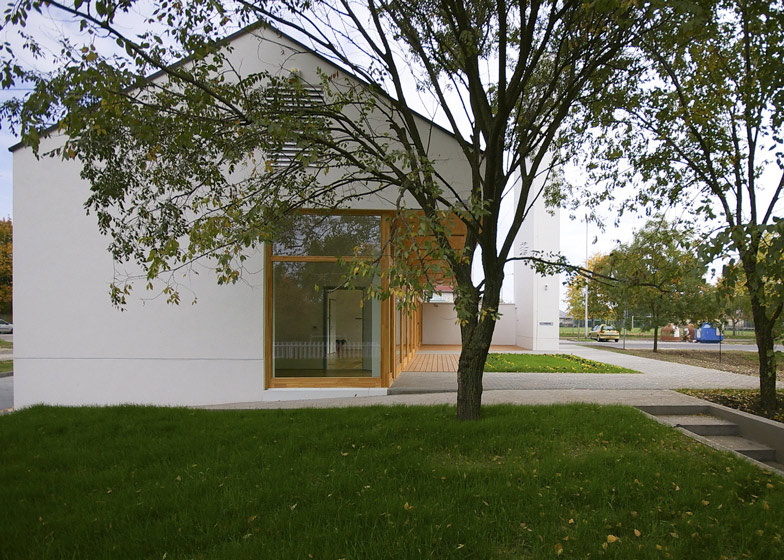A rectilinear belfry towers above the geometric white volume of this church congregation hall in Hungary by local firm SAGRA Architects (+ slideshow).
The Szolnok Reformed Church Congregation House is the first of two buildings by SAGRA Architects to be completed on the site in Szolnok, central Hungary, following a competition to design a new church complex.
The single-storey building contains a hall capable of accommodating around 30-40 people, an office and kitchen facilities, providing spaces that can be used for either worship or other community activities.
A wall extends out from the eastern side of the building, connecting the structure with the bell tower and creating a secluded terrace in front of the glazed southern facade.
This facade is also slightly recessed to allow part of the gabled roof to function as a canopy across the entrance.
"The basis of our concept was to create an open, clear and transparent space that still represents protection," explained architect Gábor Sajtos.
Exterior walls are rendered white, while the roof is clad with black slate tiles and windows are framed by stained wood.
"The materials used reflect the spirituality of the building," said Sajitos. "The white plastered walls and black slate roof suit its austerity and noble simplicity."
Construction on the neighbouring church has not yet begun, due to problems securing funding. Once complete, it will be positioned on the northern boundary of the site, while remaining spaces between the two buildings will feature flower gardens.
Read on for more information from Sagra Architects:
Congregation House - SAGRA Architects
"... but love builds people up" - 1 Corinthians 8
The design process was preceded by an architectural competition. The SAGRA Architects' design was rewarded as the winning proposal.
The congregation house is multifunctional: besides operating as congregation hall it houses catechism classes and programmes, fulfils social duties and charity tasks. As the building is also an eco-point, its programmes play part in spreading ecological thinking and teaching sustainable behaviour.
The basis of our concept during the design of Szolnok Reformed Church Congregation House was to create an open, clear and transparent space that still represents protection. Due to its architecture the building serves as a suitable place for worship and community occasions.
The building complex has two parts: the single-storey, cantilevered volume of the congregation house with gabled roof and the Bell tower. The bell tower is an organic part of the complex. The wooden terrace, inserted between the congregation house and the tower extends and opens up the internal community space through a fully openable glass wall. The cantilevered roof creates a transition zone between inside and outside. The south facade is shaded by the strongly cantilevered roof in summer, while it lets in the sharp angled sunbeams in winter.
The composition of the buildings is completed by the lavender garden, the floral garden and the lawn garden with seating and water surface.
The main access to the building is from south, from the street. Here the visitor is led through a pulled back, transition entrance area. The bell tower's volume leads into the site. The walls, built on the southern and western site boundaries are the integral parts of the complex, symbols of protection, but open up and lead in at the same time. Placing the buildings on the site boundaries is also part of the local building regulations. Through these walls open up, the site becomes private but still open for passing through from all directions.
The congregation hall is extendable towards the wooden terrace. The terrace becomes the full, open-air part of the hall in summer.
The materials used reflect the spirituality of the building. The white plastered walls and black slate roof suit to its austerity and noble simplicity. The doors, windows and the south facade of the building are covered with stained wood, as well as the underside of the cantilevered roof.
As the building is also an eco-point, its programmes play part in spreading ecological thinking and teaching sustainable behaviour, so we considered this aspect during the design process.
The heating and hot water supply of this low energy, economical building is solved by an air to water heat pump. The heating is radiating surface heating (heated floor and ceiling), the cooling is provided by radiating surface cooling from the ceiling. The temperature of the spaces is controlled by thermostatic valves.
The south facade is shaded by the strongly cantilevered roof in summer, while it lets in the sharp angled sunbeams in winter.
Future
The church complex contains three main masses: the church, the congregation house with pastor's office and the bell tower. The three volumes form an inseparable unity.
Until now the congregation house and the bell tower were built. The congregation is aiming to construct the church too in the future, but the financial background for it is still missing.
Architects: Sagra Architects
Architect in Charge: Sajtos Gábor
Design team: Sajtos Gábor, Grand Gabriella, Páll András, Virág Péter, Németh Regina
Year: 2012
Location: Szolnok, Hungary
Photographs: Szentirmai Tamás










